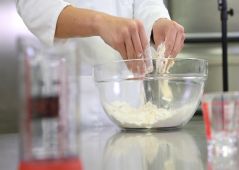Fats and oils: shortening

A shortening is defined as a fat, solid at room temperature, which can be used to give foods a crumbly and crisp texture such as pastry. Examples of fat used as “shorteners” include butter, margarine, vegetable oils and lard.
How does it happen?
Oils and fats are used in a baked product to reduce the development of gluten giving the foods a crumbly texture. The fats and oils break down the gluten into “shorter strands” hence the term shorteners. Coating the flour in fat prevents the flour from absorbing water hindering the formation of gluten. If too much gluten developed, the food would be stretchy and elastic.
Shortening is used in most doughs and batters, to give the baked product a crisp and crumbly texture. Rubbing the fat in causes the baked product to have a flaky texture, as the dough is separated into layers. When fat is whisked with sugar, a process called creaming, the texture will be more like a cake, and be soft and springy.
The type of fat used will also affect the colour of the product. For example, using margarine will give the baked product a golden colour, whereas lard produces a product with a pale yellow colour.
Recap: fats, solid at room temperature can give food a crumbly texture. They are called shorteners as they break down gluten into shorter strands, hindering the formation of gluten (which would make the dough more stretchy) by preventing the flour from absorbing water.
More information
OCR Topic exploration pack: Pastry


